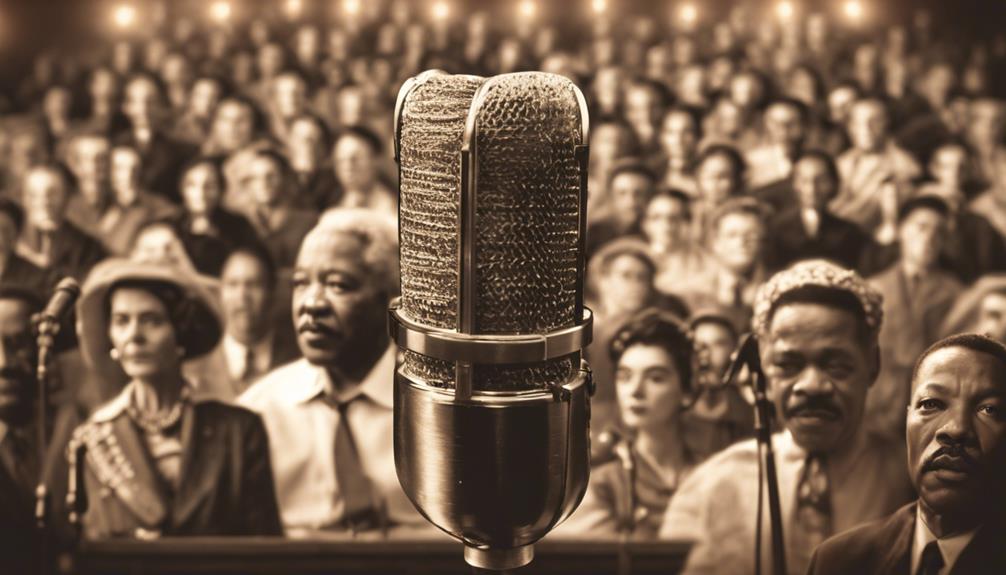For optimized impact, TED Talks follow the 18-minute rule, aligning with human attention spans and cognitive capacity. This timeframe aids in preventing cognitive overload, enhancing clarity, and boosting audience engagement. By focusing on concise delivery of key concepts, speakers can avoid information saturation while promoting information retention. The science behind this rule is grounded in neuroscience principles, ensuring that talks remain engaging and memorable. This strategic imperative is not just a recommendation, but a cornerstone in crafting compelling presentations. Understanding the ideal length of TED Talks can greatly influence the impact and effectiveness of your communication.
Key Takeaways
- TED Talks are ideally 18 minutes long to prevent cognitive overload.
- 18 minutes align with human attention span and energy consumption peaks.
- Maintains audience engagement by balancing depth of content and interest.
- Adherence to the 18-minute rule aids in information retention.
- Neuroscience principles support 18-minute talks for optimal impact.
Impact of TED Talks' 18-Minute Rule
Additionally, the Impact of TED Talks' 18-Minute Rule on audience engagement and information retention is significant due to its role in optimizing speaker communication and maintaining interest levels. By adhering to the 18-minute rule, TED speakers can effectively convey their message without overwhelming the audience with excessive information. Research supports that most individuals can concentrate for a span of 10 to 18 minutes, making this time frame ideal for absorbing new concepts and ideas.
The 18-minute duration of TED Talks also helps in preventing cognitive overload, ensuring that viewers can digest the information presented without feeling mentally exhausted. This strategic time limit encourages speakers to focus on their key points, enhancing clarity and coherence in their presentations.
Additionally, the concise nature of TED Talks contributes to their viral sharing potential, as viewers are more likely to share bite-sized, impactful content with their networks. Ultimately, the 18-minute rule plays a pivotal role in the success and widespread reach of TED Talks.
The Science Behind TED's Time Limit

Given the scientific basis underlying TED's time limit, it's essential to understand the cognitive mechanisms that support the effectiveness of the 18-minute duration. Research indicates that the human brain's energy consumption plays an important role in determining attention span.
The 18-minute rule aligns with this understanding, as it corresponds to the ideal timeframe within which most individuals can attentively listen. TED Talks' adherence to this timeframe allows speakers to maintain clarity in their presentations, focusing on delivering impactful and concise messages.
By honing in on a single idea per talk and avoiding information overload, TED guarantees that the audience remains engaged throughout the duration of the presentation. This strategic approach not only captivates viewers but also contributes to the talks' viral success and enduring impact.
The 18-minute limit, rooted in cognitive science and attention mechanisms, serves as a cornerstone of TED's formula for delivering compelling and memorable content.
Why 18 Minutes Enhance Audience Engagement

Enhancing audience engagement, the 18-minute duration of TED talks effectively balances depth of content with maintaining interest. This specific timeframe aligns well with the typical human attention span, which ranges from 10 to 18 minutes.
Research indicates that the brain's energy consumption peaks after roughly 18 minutes of focused listening, making it an ideal duration for impactful communication. The 18-minute rule not only challenges speakers to distill their ideas to their most impactful essence but also helps prevent cognitive backlog, ensuring that the audience can absorb and retain the information presented.
By delivering short, focused presentations within the 18-minute timeframe, TED speakers can maintain audience engagement throughout the talk. This balance between providing sufficient depth of content and keeping the audience interested makes TED talks highly effective in delivering their messages.
The 18-minute duration serves as a strategic tool in maximizing the impact of these talks on the audience's understanding and retention of the presented ideas.
Maximizing Impact Through Talk Length

To maximize the impact of your talk, consider the length carefully to guarantee audience engagement and retention of key ideas. TED Talks are limited to 18 minutes with the aim of maximizing audience engagement.
Research indicates that most people's attention span peaks at around 10 to 18 minutes, making the 18-minute duration of TED Talks ideal for capturing and maintaining viewers' interest. By adhering to this time limit, speakers are encouraged to be concise and focus on essential concepts, preventing cognitive overload and ensuring that key ideas are effectively conveyed.
Shorter, more frequent sessions have been proven to aid in information retention, further emphasizing the effectiveness of the 18-minute rule. The carefully curated duration of TED Talks strikes a balance between seriousness and audience attention, making it a powerful tool for delivering impactful and memorable presentations.
Neuroscience Support for 18-Minute Talks

The neuroscience-backed 18-minute rule in TED Talks optimizes information retention and audience engagement. Research indicates that a 5-minute lecture causes less cognitive backlog compared to a 30-minute lecture. Audience attention span typically peaks around the 10-minute mark, emphasizing the importance of re-engaging the audience every 10 minutes to maintain their focus. TED speakers adhere to the 18-minute rule as spending too much time on a pitch can lead to cognitive backlog and reduced retention. By structuring their talks within this timeframe, speakers leverage neuroscience principles to deliver impactful presentations that resonate with their audience.
| Neuroscience Support for 18-Minute Talks | ||
|---|---|---|
| Key Points | Implications | Application |
| 5-minute lecture causes less cognitive backlog | Optimize audience engagement | Structure talks within 18 minutes |
| Audience attention span peaks at 10-minute mark | Maintain focus and retention | Re-engage audience every 10 minutes |
Frequently Asked Questions
How Long Should a TED Talk Be?
A TED Talk should be around 18 minutes. This duration allows for focused communication and maintains audience interest. Keeping it concise guarantees clarity and impact. Shorter sessions enhance retention and engagement, making your talk more effective.
What Is the 18-Minute Rule for TED Talks?
You know, when it comes to TED Talks, the 18-minute rule is key. It's like a magic recipe – just enough time to captivate, inform, and inspire. Keep it tight, focus on impact!
What Is the Customary Time Limit for TED Talks?
The customary time limit for TED Talks is 18 minutes. Keeping presentations concise and impactful, this duration guarantees audience engagement. Speakers adhere strictly to this rule to enhance message delivery and retention, maximizing impact.
What Is the 18 Minutes Rule?
Imagine capturing attention and conveying ideas effectively. The 18-minute rule in TED Talks achieves just that. It's based on research for maximum engagement and online success. Speakers condense messages, ensuring impact and audience engagement.
What Is the Ideal Length for a TED Talk to Have the Most Impact?
The perfect duration of ted talk is often said to be around 18 minutes. This length allows speakers to deliver their message effectively without losing the audience’s attention. Research has shown that talks around this length are more likely to have a lasting impact on the viewers.
Conclusion
To sum up, TED Talks have proven the effectiveness of their 18-minute rule in capturing audience attention and delivering impactful messages. By adhering to this time limit, speakers can maximize engagement, retention, and overall impact on their listeners.
The science behind the 18-minute length is supported by neuroscience, highlighting the importance of concise and focused communication.
So, next time you prepare a presentation, consider the power of brevity in leaving a lasting impression on your audience.









